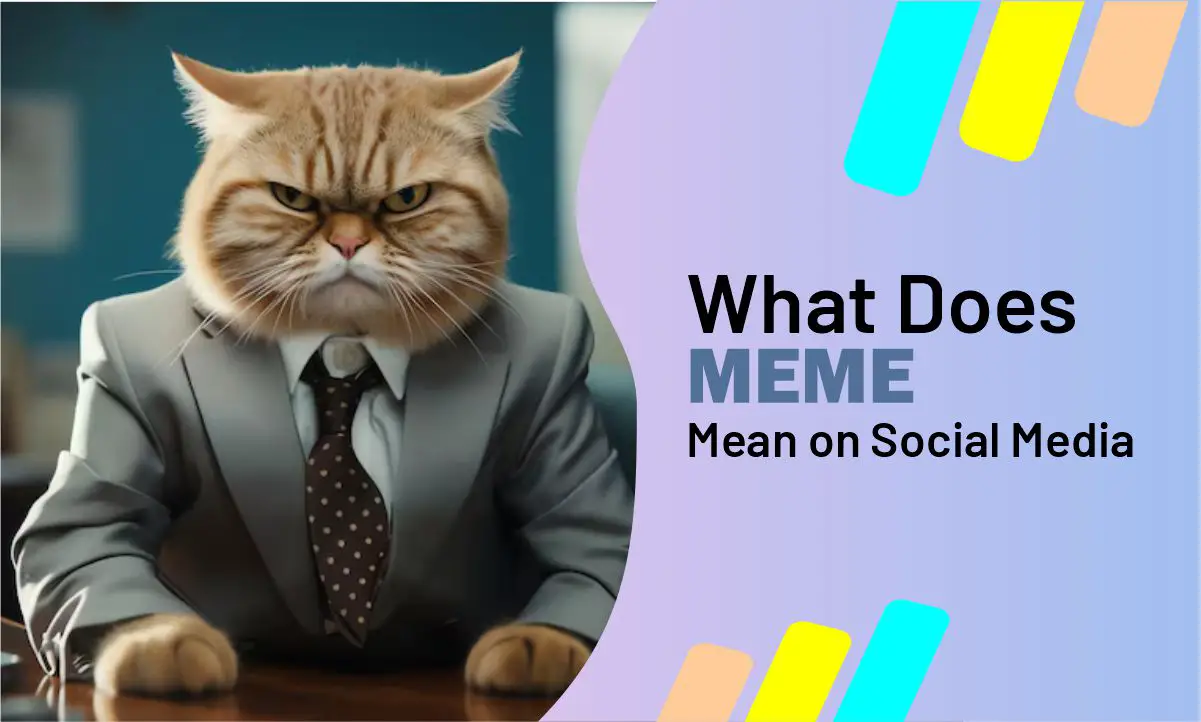What Does MEME Stand For?
Strictly speaking, “MEME” isn’t an acronym that “stands for” a longer phrase. Instead, the word “meme” originates from the Greek word “mimema,” meaning “imitated thing.” The modern term “meme” was coined by evolutionary biologist Richard Dawkins in his 1976 book The Selfish Gene.
Dawkins used it to describe an idea, behavior, or style that spreads from person to person within a culture, much like genes carry biological information. In today’s digital age, “memes” have evolved into a powerful and highly recognizable form of communication on social media, encapsulating humor, commentary, and cultural identity in instantly shareable formats.
What is a Meme on Social Media?
On social media, a meme refers to a piece of media, often humorous, that spreads rapidly across the internet. It can take the form of an image, video, GIF, text post, or combination of these elements. The defining feature of a meme is its relatability and ease of replication or adaptation by others.
Memes typically have the following characteristics:
- Humor or Satire: Most memes are funny, sarcastic, or ironic.
- Relatability: They reflect shared emotions, experiences, or cultural moments.
- Reproducibility: Memes often come with templates that others can customize.
- Viral Potential: Successful memes are easily shareable and often spread across multiple platforms like Twitter, Instagram, TikTok, Reddit, and Facebook.
Memes have become a universal language, capable of conveying complex ideas, social commentary, or simple jokes in a quick, digestible format.
The Origin of the Term ‘Meme’
Richard Dawkins introduced “meme” to explain how cultural information spreads and evolves. He likened memes to genes, suggesting that ideas mutate and evolve based on human interaction. Examples from pre-internet history include folktales, songs, dances, and fashion trends — all examples of cultural memes.
However, with the rise of the internet, the term “meme” has shifted primarily toward describing humorous or viral internet content. While Dawkins’ original definition was broad and academic, today’s memes are tightly tied to digital life.
Examples of Popular Memes
Memes are often recognized by the viral images or video snippets they use. Here are a few iconic examples:
- Distracted Boyfriend: A stock photo showing a man turning away from his girlfriend to admire another woman. It is used to humorously depict divided attention or shifting loyalties.
- Woman Yelling at a Cat: A split-screen image featuring a woman yelling and a confused-looking cat sitting at a dinner table. It’s often used to express outrage met with indifference.
- Success Kid: An image of a toddler with a determined fist. It represents achieving small or large victories.
- Drakeposting: Images of rapper Drake rejecting one option and approving another, often used to compare two contrasting ideas or preferences.
- This is Fine: A cartoon dog sitting calmly in a burning room. It’s typically used to represent denial or acceptance of a bad situation.
- Sad Keanu: A paparazzi photo of actor Keanu Reeves looking melancholic on a park bench, often paired with captions about loneliness or existential thoughts.
Different Types of Memes
Memes aren’t restricted to just one style. Here are several major types:
- Image Macros: Classic memes that feature text overlaid on an image, like “Bad Luck Brian” or “First World Problems.”
- Video Memes: Short video clips, often edited for humor or satire, such as “Rickrolling” (sending someone a link to Rick Astley’s “Never Gonna Give You Up”).
- GIF Memes: Animated loops used to convey reactions, emotions, or jokes.
- Hashtag Memes: Memes formed around trending hashtags, like #10YearChallenge.
- Reaction Memes: Memes that capture a reaction to an event or statement, often using celebrities or popular TV scenes.
- Text-Only Memes: Short jokes, puns, or observational humor shared in text form.
Why Are Memes So Popular?
Memes have become an essential part of digital culture because they meet several important needs:
- Easy Communication: Memes can express complex emotions, political views, or social criticisms in just a few seconds.
- Relatability: They allow people to bond over shared experiences, like bad Wi-Fi, relationship struggles, or work frustrations.
- Entertainment Value: People naturally enjoy humor, surprise, and wit, all of which are abundant in memes.
- Viral Nature: Memes are designed to be easily modified and shared, increasing their chances of reaching a massive audience.
- Cultural Commentary: Memes often react to news, politics, or social trends, serving as a collective voice.
How Memes Influence Society and Culture
Memes aren’t just entertainment; they have real influence:
- Political Movements: Memes have been pivotal in modern political discourse, from the 2016 U.S. election to protests worldwide.
- Brand Marketing: Companies use memes to connect with younger audiences, showing a sense of humor and cultural awareness.
- Awareness Campaigns: Nonprofits and activists use memes to raise awareness for social causes like climate change, mental health, and equality.
- Fashion and Merchandise: Memes have transcended digital screens to influence fashion, merch, and even art exhibitions.
Memes as a Marketing Tool
Brands have embraced meme marketing to tap into viral culture. Companies like Wendy’s, Netflix, and Duolingo are famous for using meme formats to engage audiences.
Successful meme marketing requires:
- Authenticity: Trying too hard can backfire; audiences can spot forced attempts to be “cool.”
- Cultural Awareness: Marketers must understand the meme’s context to use it effectively.
- Speed: Memes have a short lifespan; brands must act quickly to stay relevant.
The Evolution of Memes
Internet memes have evolved from simple image macros to sophisticated multimedia experiences:
- Deep-Fried Memes: Exaggerated and heavily edited images with distorted colors.
- Surreal Memes: Absurdist or nonsensical humor that defies traditional joke structure.
- Dank Memes: Highly ironic, often edgy memes that cater to niche online communities.
- Wholesome Memes: Positive and uplifting memes focusing on kindness, support, and self-care.
Platforms Where Memes Thrive
Different platforms cater to different types of meme culture:
- Reddit: Especially subreddits like r/memes and r/dankmemes.
- Twitter: Quick, witty memes often tied to trending topics.
- Instagram: Visual memes, meme pages, and carousel meme dumps.
- TikTok: Video memes, challenges, and trending sound bites.
- Facebook: Meme groups catering to all ages and interests.
Memes and Generational Differences
While Gen Z and Millennials often create and consume memes fluently, older generations are increasingly engaging with meme culture too. However, different generations often have their own distinct meme styles, humor, and references.
Memes and Mental Health
Memes can also impact mental health in both positive and negative ways:
- Positive: Sharing relatable memes can foster connection and reduce feelings of isolation.
- Negative: Constant exposure to ironic or dark humor can sometimes reinforce cynicism or detachment.
Future of Memes
The future of memes could see integration with:
- Artificial Intelligence: AI-generated memes tailored to your sense of humor.
- Augmented Reality (AR) Memes: Interactive memes you can experience through smart devices.
- Blockchain and NFTs: Unique meme creations sold and owned digitally.
Conclusion: Memes as Modern Cultural Artifacts
Memes have become much more than quick jokes; they are modern cultural artifacts that document our emotions, politics, humor, and social trends. From Richard Dawkins’ original concept of ideas spreading like viruses to today’s viral internet memes, the journey has been fascinating.
Memes allow people around the world to laugh together, critique society, and bond over shared experiences. As technology advances and culture shifts, memes will continue evolving, staying at the heart of online communication and creativity.
Read these also:
- What Does ISO Mean
- What Does “Moots” Mean
- What Does GOAT Mean
- What Does “W – WIN” Mean
- What Does Boujee Mean
- What Does TBF Mean
- What Does “Trending” Mean
- What Does Side Eye Mean
- What Does H/T Mean
- What Does LMR Mean
- What Does Ate Mean
- What Does ION Mean
- What Does Sheesh Mean
- What Does CFBR Mean
- What Does “FR” Mean
- What Does MBN Mean
- What Does ‘IDGI’ Mean
- What Does IYKYK Mean
- What Does “WTMS” Mean
- What Does “Slay” Mean
- What Does CFS Mean
- What Does “Delulu” Mean
- What Does TFW Mean
- What Does SMH Mean
- What Does TBT Mean
- What Is a Profile Picture (PFP)
- What Does “Spill The Tea” Mean
- What Does Bussin Mean
- What Does ‘Gram’ Mean
- What Does OPP Mean
- What Does Finna Mean
- What Does “POV” Mean
- What Does Cringe Mean

